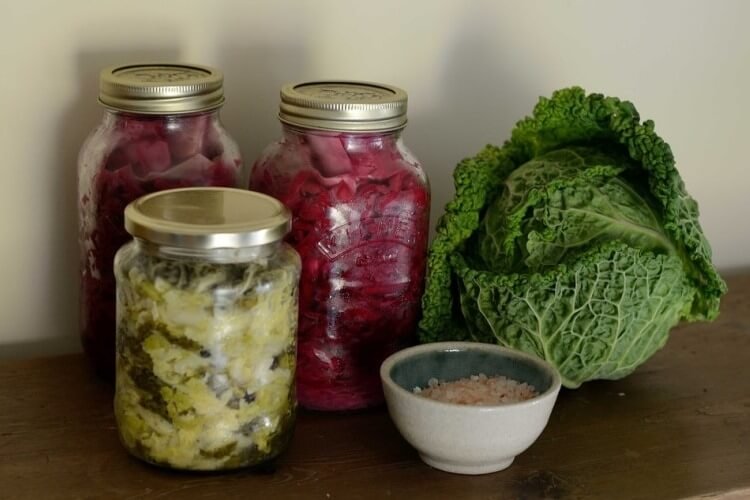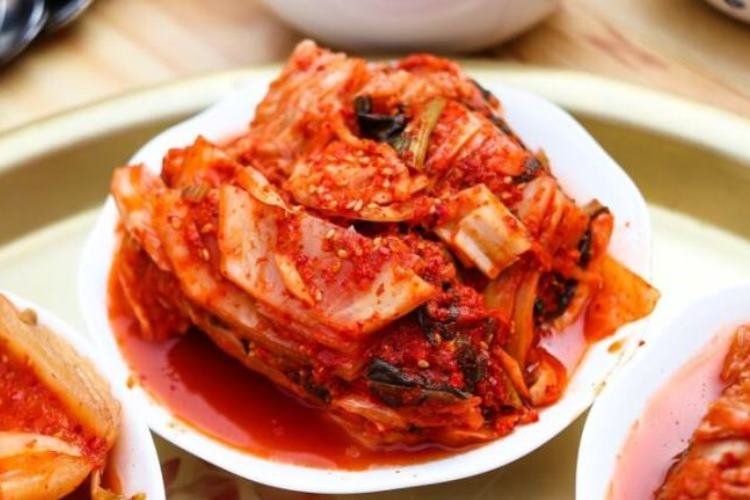Fermented foods have been part of our diet for millennia, going as far back as 6,000 BC.
These days, they are commonplace. Dairy is the obvious choice and arguably the first food to be fermented. But whole foods like vegetables, fruits, meat, fish and legumes can also be fermented and eaten.
It’s highly improbable though that our ancestors knew the ins and outs of the fermentation process, and the likelihood is that the first glorious fermentation happened by accident.
Chances are slim that someone woke up one fine morning and went “I am going to the barn, request Bessie for a couple of quarts and whip up some yogurt.”
So, how does one ferment food?
We will get on to that in a bit. But first, let’s look at the types of fermentation.
Types of fermentation
- Lactic acid fermentation (vegetables)
- Ethanol fermentation (wine, beer, etc.)
- Acetic acid fermentation (cider vinegar, kombucha, etc.)
For this post, let’s focus on the first one.
How to ferment vegetables

There’s a reason why fermentation of vegetables has stood the test of time. The process promotes good microbes and, as a result, keeps the food healthy. Also, it protects the food from mold (the while cloud-like thing that sits atop food) and decay.
Do not be intimidated. Fermenting food is a piece of cake or, in this case, bottling vegetables in salt water.
It’s really that simple and even the math that’s involved is as easy as apple pie. (This is the last of the food analogies, I swear.)
Now on to the important matter at hand – the process. This is as basic as it gets, fun and healthy.
First, you have to clean a glass jar where you are going to concoct the potion. Make sure the cap is air tight.
Wash the vegetables you intend to ferment.
Place them in the jar and pour water up to a level that the vegetables are completely submerged in it. This is to cut off the oxygen from the vegetables and prevent them from catching mold.
Then there is the salt, which is the most important aspect of this process. One, it guards against bad bacteria and, two, it helps to preserve.
So, how much do you use. A pinch? A tablespoon dollop?
There is no exact mount but you can achieve really good results if you put 2.5-3 percent of the combined weight of the vegetables and the water.
For example, if the combined amount is 500 gms then the amount of salt you put in is 2.5/100*500 which is 12.5 gms.
Here’s how you do it.
You take off the water from the jar and pour it into another container. Incorporate the salt, mix it well and pour the water back into the first jar again.
And voila! You are ready to ferment you veggies.
Other important points to keep in mind while fermenting foods
Keep them stored at 60-80 degrees Fahrenheit. Lower than 60 then the fermentation process will be slow. Higher than 80 then you must check your vegetables regularly or they may get spoiled.
To ensure that the vegetables rest below the level of water, you can use weights that fit the jar. (Check that the weights are not made of material that will spoil the fermentation process.)
Also, you can try keeping the lid a little loose so that CO2 can escape. Not a hard and fast rule though. CO2 can give the vegetables fizz and a unique flavor.
How long does it take to ferment?
Good microbes spring into action and get rid of the bad bacteria for the first day or so.
From day two onwards, they start to convert sugar and you will notice a tangy smell, which is not a bad thing by the way. It shows you are halfway there.
After the first week you start to age your veggies. You can dive into them right there and then, but the more you keep it (we’re taking months) the better the kick in your product.
So simple. Maybe the world’s most renowned fermented dishes require a lot more skill? Nein. Non. Nada. No.
Most were originally basic. They were inventions of necessity, when our ancestors realized it was difficult to grow crops in winter and a bear-like hibernation was not an option (Sadly 🙁 ).
Popular fermented foods

Take the Korean dish kimchi for instance. Winters in Korea are extremely cold and this affected the agriculture produce. So, people began to use salt to preserve their vegetables. The first version of kimchi was made over 2000 years ago, probably from the abundantly grown radish.
These days, kimchi is a staple in Korean cuisine with cabbage as the fermented vegetable of choice.
Then there is sauerkraut, which is not exactly German as the name would imply but a Chinese invention that traders took back to Europe. It all began when the Great Wall was being built. The workers, as a way to preserve vegetables during the winter months, conjured up the neat trick of adding rice wine to cabbage.
The most common modern way of making sauerkraut involves cabbage and pickling salt.
The Japanese’s natto has more fantastic origins. One tells of a Samurai lord whose army had to quickly flee a village when enemy approached. The boiled soybeans they hurriedly wrapped in straw bags fermented over the days and natto was born.
Another tells of a devout prince whose boiled soybeans (also wrapped in a straw bag) that he was carrying turned into natto. So, the bottom line is… if you want authentic natto, pack your boiled beans in straw bags :)!
Today’s natto is made by adding a probiotic strain to boiled soybeans.
While the joys of fermented foods were discovered more than thousands of years ago, the understanding of their benefits came much later, in the 20th century.
Fermented foods benefits
Even if you take a magical broom to your stomach it will never be free of bacteria and microbes. Their numbers are not in the thousands or millions but over 100 trillion.
But don’t worry.
There are good guys and nasty ones. The side we pick – and that depends so much on our diet – determines the health of our gut.
Fermented foods, which contain probiotics (bacteria that are good for our gut), make a favorable environment for the good guys to thrive.
The benefits are plenty.
One is that fermentation brings out health potential in foods that they do not possess in their original form. For example, fermented vegetables have vitamin B12 which is not available in plant foods.
The support for the beneficial bacteria that fermented products provide also combats leaky gut syndrome which is a condition of weakening of the intestine walls. If not treated, a leaky gut can result in several diverse ailments, from eczema to Alzheimer’s disease.
Fermentation also helps to break down compounds found in nuts, seeds and legumes that hamper nutrient absorption.
While the jury is still out on this one, some studies have shown a possible link between fermented food and weight loss.
Moreover, these foods are known to reduce blood pressure and control bad cholesterol.
The presence of iron, vitamin C, and zinc in these foods also helps strengthen the immune system which enables you to recover quicker from illnesses.
Bottom line is that these are essentially superfoods which also happen to be extremely easy to make at home.
And while on superfoods, check out our version of the underrated South Asian staple, Sattu.
Probiotics in fermented foods
Probiotics is closely linked with fermented foods though one must know that all fermented foods do not contain probiotics.
Yoghurt does. Foods such as vegetables and fruits that naturally contain probiotics can also be fermented.
But if you are looking for fermentation benefits in pasteurized foods, you’re barking up the wrong tree.
Pasteurization kills bacteria.
It all depends of how the food is fermented. Foods that are fermented using live cultures and live organisms have probiotics.
However, some that you get in commercial stores are not fermented using live cultures but rather substances like vinegar. These do not contain probiotics.
To be sure, read the labels and look carefully for the words “naturally fermented.”
Fermented foods are generally safe but there are times when contaminated bacteria can cause illness. And it may not be ideal for people suffering from specific conditions.
Let’s move on to some cons of fermented foods. Nothing is perfect in this world, right?
Disadvantages of fermented foods
Fermented foods can cause bloating which is a consequence of the excess gas that is generated when probiotics get rid of fungi and harmful bacteria.
Amines that break down amino acids in fermented foods can result in fluctuating blood flow in certain individuals, which can lead to migraine and headaches.
Fermented foods also contain histamine that is digested by the body’s enzymes. Some people do not have these enzymes, which means the histamine can find its way to the bloodstream. This can cause conditions such as migraine and itching and, in some cases, asthma and low blood pressure.
Probiotics are also known to cause infection in people with low immunity and possess genes that are resistant to antibiotics.
However, let not these dissuade you from treating yourself with kimchi, miso, tempeh, sauerkraut, and other wonderful fermented foods that the world offers. If you are not too sure about them, ask a medical professional, hopefully get the green signal, and improve your mood and the health of your gut. God knows I need both.
Do you take fermented foods? Do you have a particular favorite(s)? What has been your experience with them? Let us know in the comments.


16 comments
Helpful article. Keep them coming!
Glad you found this helpful. : )
Having my roots back from the east I relish fermented food a lot and fermented drinks too. This article is so detailed and must appreciate the effort you put in. While I was reading your article my taste buds were dancing with joy and could smell it in my mind, took me back home. Fermenting foods is definitely in my next to do list.
Thanks Yogesh! 🙂
Thank you so much for sharing this, it was a very interesting read! I haven’t tried natto yet and need to give a second chance to kimchi. But I am a huge fan of kombucha. Thank you for sharing the process 🙂
Thank you! I’m a huge fan of most fermented foods. Happy you found the post useful 🙂
Thank you so much! I have never thought of making my own. It’s always fun to try new things with food. 🙂
It is indeed especially when they come with many benefits 🙂
This was such an interesting post and a great read! Thanks for including so much information – I love sauerkraut but have never tried any of the others you’ve mentioned! Maybe I’ll have to give them a go!
Thanks Charley. Kimchi and natto some of us have to get used to I guess. But once you’re there, it’s so much fun :).
I love fermented vegetables; they gain so much flavor during the fermenting process. Fermented or pickled red onions are a favorite on salad with tempeh and bleu cheese, and last year we grew patches of Chinese cabbage and made three gallons of kimchi. It lasts so long and makes a delicious addition to fried rice or stir-fry.
Thanks so much for sharing this additionally informative post! 🙂
Most fermented foods are such versatile dishes. And three gallons of kimchi?! You’ve inspired me to go cabbage hunting 😀
Thank you for sharing this, this was such an informative and interesting post and I definitely learned something new. Can’t say this is something I’ve ever really thought about!
Thanks Jenny and I am glad you found the post useful. Fermented foods can be quite fun.
This is such a useful post. I can’t say that I’ve ever really thought of fermenting my own food before but this made it seem a lot less scary to do. Thanks for sharing.
Tash – A Girl with a View
I am happy you found value in the post. Most fermented foods are quite simple to make and fun to eat 🙂
Comments are closed.